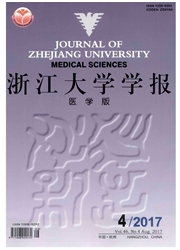

 中文摘要:
中文摘要:
目的:探讨姜黄素对慢性阻塞性肺疾病(COPD)模型大鼠肺动脉平滑肌细胞的作用及其分子生物学机制。方法:将75只雄性Wistar大鼠随机分为正常对照组,模型对照组,姜黄素小剂量组、中剂量组和大剂量组,采用HE染色法观察肺动脉管组织学形态,免疫组织化学染色检测增殖细胞核抗原(PCNA)、凋亡相关蛋白Bcl-2、Bax,TUNEL法检测姜黄素对平滑肌细胞凋亡的影响,蛋白质印迹法检测肺组织SOCS-3/JAK2/STAT通路相关蛋白表达情况。结果:模型对照组右心室收缩压(RVSP)、右心室肥大指数(RVMI)均高于正常对照组(均P〈0.05),姜黄素大剂量组和中剂量组RVSP、RVMI均低于模型对照组(均P〈0.05);模型对照组肺动脉管增厚、平滑肌细胞数量显著增多,而姜黄素中剂量组和大剂量组肺动脉管变薄、平滑肌细胞固缩、变形;模型对照组PCNA、Bcl-2相对表达量高于正常对照组(均P〈0.05),Bax相对表达量低于正常对照组(P〈0.05);姜黄素中剂量组和大剂量组PCNA相对表达量低于模型对照组(均P〈0.05),Bax相对表达量高于模型对照组(均P〈0.05);模型对照组SOCS-3蛋白减少、而磷酸化JAK2、STAT1、STA13增多,姜黄素中剂量组和大剂量纽SOCS.3蛋白增多,磷酸化JAK2、RVMISTAT3减少。结论:姜黄素可促进COPD大鼠平滑肌细胞凋亡,改善平均肺动脉压以及RVMI,这一作用可能与刺激SOCS-3/JAK2/STAT信号途径有关。
 英文摘要:
英文摘要:
Objective: To investigate the effects and the underlying molecular mechanisms of curcumin on pulmonary artery smooth muscle cells in rat model with chronic obstructive pulmonary disease (COPD). Methods: A total of 75 male Wistar rats were randomly divided into control group (group CN), model group (group M), low-dose curcumin group (group CL), medium-dose curcumin group (group CM) and high-dose curcumin group (group CH ). HE staining was used to observe the morphology of pulmonary artery. Proliferating cell nuclear antigen (PCNA), apoptosisrelated protein Bcl-2 and Bax were detected by immunohistochemical staining. TUNEL kit was used to analyze the effects of curcumin on apoptosis of smooth muscle cells, and the protein expressions of SOCS-3/JAK2/STAT pathway in lung tissues were determined by western blot. Results: Right ventricular systolic pressure (RVSP) and right ventricular hypertrophy index (RVMI) in group M were significantly higher than those in group CN, group CH and group CM ( all P 〈 0. 05 ). HE staining and TUNEL kit test showed that the number of pulmonary artery smooth muscle cells had a significant increase in group M, while the pulmonary artery tube became thin, and the smooth muscle cells shrinked in group CM and group CH. Immunohistochemistry showed that PCNA and Bcl-2 in group M were significantly higher than those in group CN ( all P 〈 0. 05), while Bax expression was significantly lower than that in group CN (P 〈 0. 05 ). PCNA in group CM and group CH were significantly lower than that in group M ( all P 〈 0. 05), while Bax expression was significantly higher than that in group M (P 〈 0. 05 ). Western blot showed that SOCS-3 protein was significantly decreased in group M, while the p-JAK2, p-STAT1, p-STAT3 were significantly increased ( all P 〈 0. 05). Compared with group M, SOCS-3 protein in group CM and group CH were significantly increased ( all P 〈 0. 05 ), while the p-JAK2, p-STAT3 were significantly re
 同期刊论文项目
同期刊论文项目
 同项目期刊论文
同项目期刊论文
 期刊信息
期刊信息
